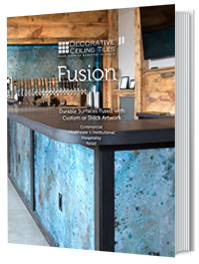Corrugated Tin Ceiling: Everything Homeowners Should Know
Written by Milan Jara on 18th Aug 2022

Corrugated tin ceilings make a bold statement in any home. Ranging from rustic to industrial, we highlight everything you need to know about the material.
Do you enjoy industrial, minimalistic, or utilitarian designs? If so, a corrugated tin ceiling may be a welcome addition to your home. While they are not commonly used for interior design, they are a popular choice for those searching for a unique way to style their space.
Corrugated tin is a popular choice among those who prefer exotic interior design. We provide tips on how to best use this creative and stylish material. If this look appeals to you, keep reading for all aspects of corrugated tin ceilings and what you need to know.
How Is Corrugated Tin Ceiling Generated?
Some homeowners may wonder what the difference is between regular stainless steel and corrugated metals. The most noticeable one is there are ripples or waves in corrugated materials that set them apart.
These sheets are treated with hot-dipped galvanization. In this process, the sheets are dipped into molten zinc baths and coated to make them less prone to corrosion. Hot-dip galvanization gives customers corrosion resistance without paying a premium for stainless steel for the same effect.
Once the tin sheets have gone through this process, they are cold rolled to produce a uniform thickness and characteristic wavy pattern.
The corrugated pattern provides increased perpendicular strength. While initially intended to give the tin sheets more strength for construction purposes, corrugated tin has been quickly adopted by those who want them for stylistic purposes.
Advantages and Disadvantages of Corrugated Tin Ceilings
The main benefit of using this material is its unique industrial appearance. It is also very versatile. For instance, if you aren’t fond of the basic silver appearance, you have several options to make the look more fitting for your space.
You can paint corrugated tin any color you wish or apply various decorative finishes and coatings to make it different from average sheet metal.
If you don’t like steel, you can also get them in brass, chrome, aluminum, or copper, and they can be bare, polished, or powder-coated. This material is a beautiful asset for those who like a more industrial style but looks equally good in a modern, rustic, or traditional home. It also looks good in any room, including the kitchen, bathrooms, and bedrooms.
While, stylistically, corrugated tin is praised, there are practical advantages to investing in it for your home decors. This material prevents mildew, mold, rot, water damage, chipping, cracking, and crumbling, and it will not warp or peel. While it is common for other ceiling types to experience staining or watermarks, this isn’t an issue with corrugated tin.
Cost is another benefit to this material. It is cheaper than stainless steel for interior ceilings since it contains the perfect amount of durability for a lower cost.
Corrugated tin is not flammable and highly safe if you are concerned about fire. Anyone can install it using the right tools.
The downside to this material is that some may not find it aesthetically pleasing since it is a robust and unique look. Some homeowners aren’t fond of using it for interior design, but for the most part, this material has no downside. It lasts forever if it has been properly coated.
Installing Corrugated Tin Ceiling
The first step is determining what type of ceiling beams your home has. Different beam types require a different set of screws.
- Pair wood beams with wood screws.
- Use self-tapping screws with metal beams.
- Concrete beams will require tan con screws.
All screws are installed using neoprene washers, and they all require hex-head fasteners.
Measure the total square footage you want to cover and screw your corrugated panels onto the ceiling, starting at the end of the room furthest from your door. Cut them to size to fit around any ceiling fans or lighting. Drill screws one inch deep every 12”.
The wider the gap between screws, the more rustic it will look. Smaller gaps provide for a cleaner-cut appearance.
Design Ideas
Rustic

You can also pair corrugated metal ceiling tiles and wooden framing to create a rustic style that combines several elements into a single location. This look pairs well with wooden floors and darker, more natural colors, like rich browns and greens. For a more extreme look, sheet the walls with corrugated tin.
Modern Corrugated Ceiling

If your space doesn’t have wooden floors or walls, you can go for more of a modern, contemporary look. This is best for those who have a modern theme and want to compliment the look creatively.
Corrugated ceilings also look excellent above a fireplace or surrounding a skylight in the kitchen. The best tip for getting a more modern look with this material is to place it in an out-of-the-way area, using it more as an accent than covering the entire ceiling.
Clean Cut Corrugated
This look works for designs that make this material the room's centerpiece. It uses silver corrugated metal paired with a neutral framing and is excellent for a modern appearance, especially one with a minimalist design.
While corrugated tin ceilings may not be for everyone, they make a statement when integrated well into any home. Many homeowners use it in man caves or garages for an industrial appeal. Some prefer to use it in a kitchen for a rustic feel, while others may use it to accent a minimalistic look.
While there are more advantages to corrugated tin ceilings than disadvantages, it makes a bold statement. The ceilings are durable, creative, low maintenance, and cost-effective, making them a popular choice for those looking to add something different to their space.





